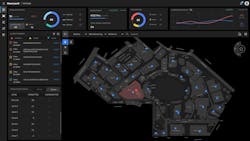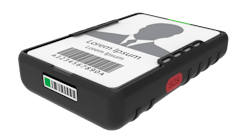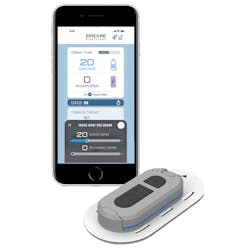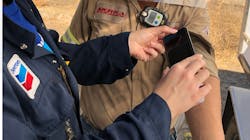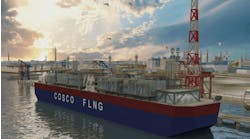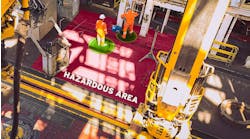Wearable technologies helping to protect offshore personnel
Editor's note: This article first appeared in the July-August 2023 issue of Offshore magazine. Click here to view the full issue.
By Ariana Hurtado, Editor and Director of Special Reports
Protecting the workforce is imperative to improving the overall effectiveness and productivity of offshore operations. Minimizing workplace injury is an important aspect of wearable technology, and this kind of personal protective equipment (PPE) continues to advance and evolve as new challenges arise.
For example, Honeywell released its Safety Watch real-time location technology earlier this year to improve offshore workers’ health and safety.
“Through radio-frequency identification technology (RFID), the solution can provide real-time data on employee location and deliver instant alerts when safety hazards are detected, leading to improved workforce safety, incident avoidance and enhanced the overall security of the industrial site,” Jorge Juan Fernandez, senior business development manager with Honeywell, told Offshore. “Safety Watch has been shown to aid with reducing mustering times from hours to minutes, expedite search and rescue operations during emergencies, and advance worker safety and policy compliance.”
“Safety Watch also includes Fatigue Management features that allow supervisors to track if a worker did not remain in the rest area long enough or if personnel has exceeded the duration of their work shift,” Fernandez added. “Through these capabilities, Safety Watch helps monitor the health and safety of their personnel while ensuring their effectiveness in the field.”
The technology can be implemented for both onshore and offshore operations.
Avoiding heat stress
Another example of wearable technology for HSE purposes is the skin patch that Chevron developed to help offshore workers avoid heat stress.
The journey began when Chevron sought out opportunities about five years ago to protect offshore Gulf of Mexico workers from heat stress. In 2020, Chevron partnered with Epicore Biosystems, a tech startup based in Cambridge, Mass., on a wearable patch that could monitor the biomarkers of dehydration.
“Chevron has been working with Epicore since 2020 conducting multiple POCs,” Louisa Reid, digital technology scout with Chevron Technology Ventures, told Offshore. “Over the course of that partnership, Epicore has made many improvements to the solution. Much of the work done with the connected hydration patch over the past year has been with the adhesive (improve adhesion to the worker and reduce the risk of skin irritation with daily use). Early results have been positive with the updates.”
Chevron announced the skin patch technology in a July 2022 news release, in which it stated it was participating in a study that pairs the wearable biometric device with a smartphone. Chevron employees would be alerted by their phone when they are at risk of experiencing heat stress.
“The biometric device—basically a skin patch with sensors—provides real-time analysis of data that can flag heat stress triggers,” the release stated. “It monitors sweat and electrolyte loss and other factors, notifying workers when to take a break, hydrate or move to a shaded area.”
So, why is something like the skin patch important for offshore workers?
“The connected hydration patch provides real-time, individual feedback. Each person sweats differently based on their body’s reaction to the hot environment,” Reid explained. “Some people are salty sweaters and require a bit more electrolyte replacement versus others. Current OSHA guidelines for fluid replacement are based on general numbers, 8 ounces of water every 20 minutes. If working over 2 hours, add an electrolyte drink. These are generalities and based on the individual and the workload, it may not be enough to replace the fluid lost. The connected hydration patch also alerts the worker if they have lost one bottle of water (500ml) and sends an alarm if the worker has lost 2% body weight, which could lead to heat illness.
“Lastly, workers who had the connected hydration patch and the app to notify them hydrated more effectively compared to those who had a patch but were not informed of the amount of fluid to replace.”
Reid said the field trial for the connected hydration patch is currently not being conducted offshore. “However, in 2022 Chevron conducted a pilot on one of our offshore platforms. After the pilot, there was a request for additional patches to assist workers who had to do welding in a hot environment (surface temperatures over 130 degrees F),” she said. “With welding, fans can’t be used to cool as they would impact the integrity of the weld. So, the connected hydration patches were used to assist the welders to hydrate and take breaks based on sweat loss. This was well received by the welders, and there were no heat illnesses reported during that specialized work.”
Safety hazard notifications
Transocean’s HaloGuard wearable locating device integrates with drill floor equipment and machine stoppage controls to help alert offshore drilling personnel when they become too close to moving equipment.
The company successfully deployed the technology in 2021 with the system becoming operational on the Deepwater Conqueror drillship in the Gulf of Mexico. Transocean planned to deploy the technology on six additional rigs by the end of that year.
“The HaloGuard system combines a wearable alarm and a real-time location transmitter together with a machine vision system that is designed to track the position of personnel on the drill floor and key drill floor equipment while operating,” a company news release stated. “When a crew member comes within a certain proximity of moving equipment, he or she is notified by an alarm through the wearable device. In the event the crew member remains in close proximity of the moving equipment, the system will stop the equipment from moving until the crew member returns to a safer, more distant position.”
Transocean’s HaloGuard methodology and technology were developed with partners Houston Mechatronics Inc. and Salunda Ltd., and it incorporates Salunda’s CrewHawk real-time location technology.

